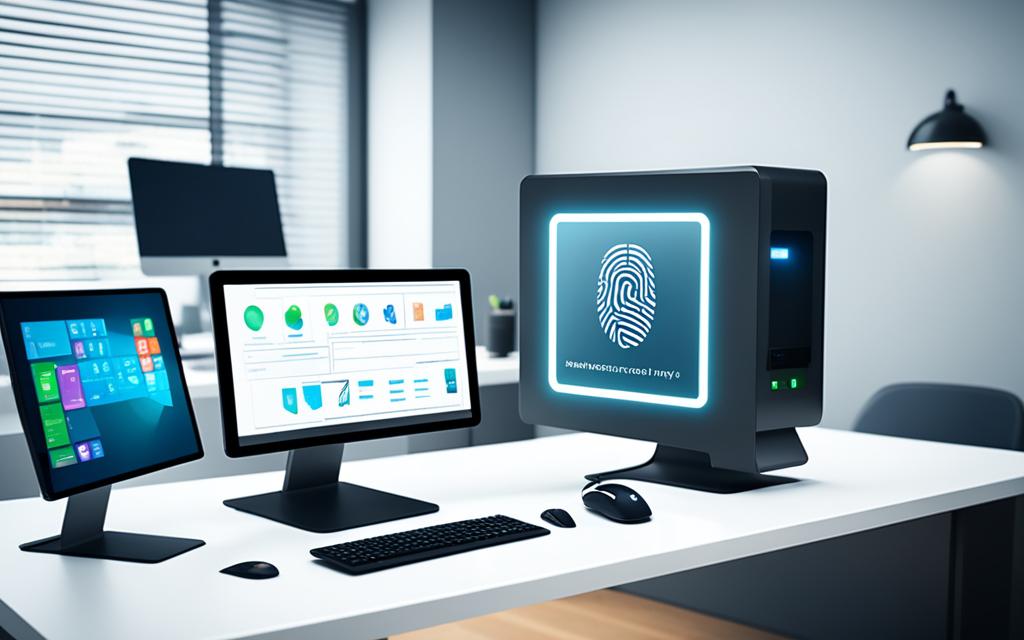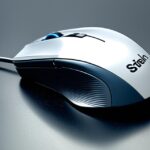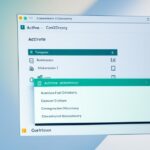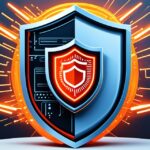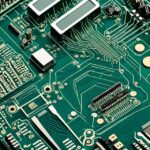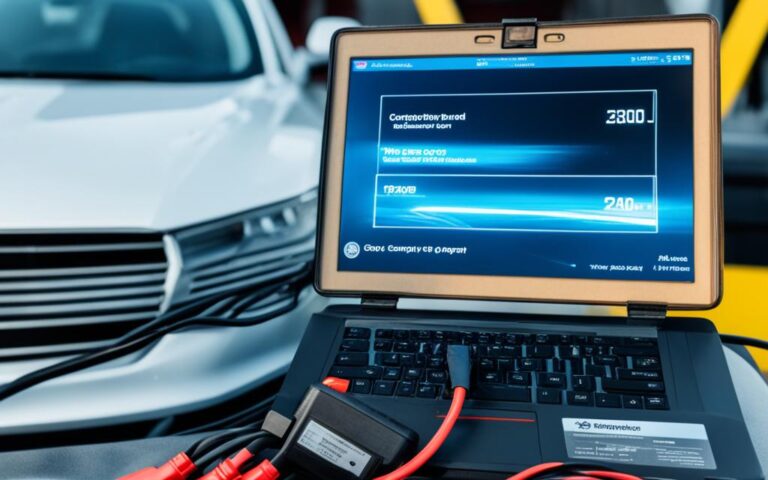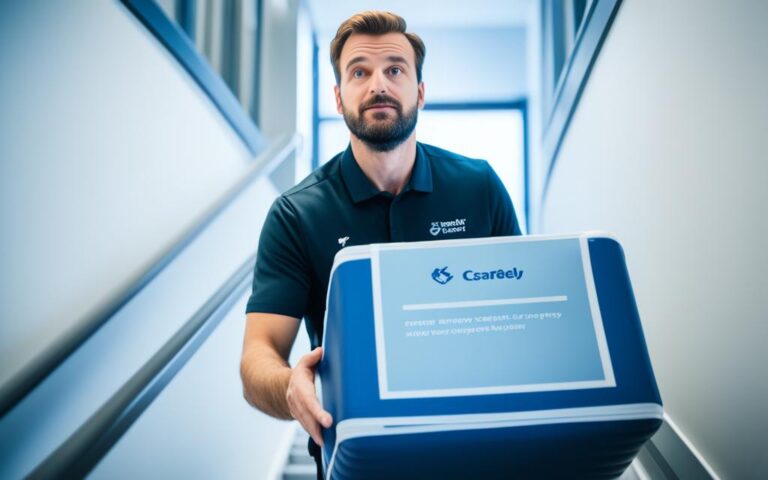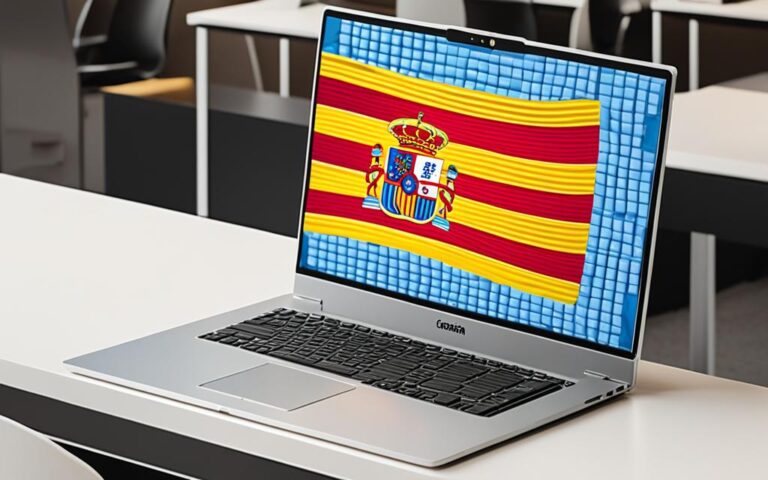According to the latest data1, some computer peripherals are okay for personal use with government equipment. They must follow certain rules to work well and stay secure.
Monitors can be used if they connect via VGA, DVI, HDMI, or DisplayPort1. This makes sure they work well with government systems.
Keyboards, mice, and trackballs are fine if they’re wired and connect via USB1. They make typing and moving the mouse easy for personal computer tasks.
USB hubs and headphones/headsets that connect via USB are also okay1. USB hubs help manage many peripherals at once, and headphones/headsets improve sound quality.
But, monitors that connect via USB, items from banned sources, Bluetooth devices, and installing drivers for personal gear are not allowed1. These rules help keep personal computer setups secure and compatible.
To keep IoT devices safe, it’s important to follow some tips1. This means setting strong passwords, turning off voice features, checking Bluetooth, and updating software often.
For home computer safety, experts suggest a few things1. This includes turning on password features, keeping software and antivirus up to date, using firewalls, and backing up files often.
Active military and civilian DoD staff can get antivirus software at a discount or for free through the DoD Antivirus Home Use Program1. This helps protect their personal computers and keep sensitive info safe.
Key Takeaways:
- Allowed personal computer items include monitors via VGA, DVI, HDMI, or DisplayPort, wired keyboards, mice, and trackballs via USB, USB hubs, and headphones/headsets via USB1.
- Items not allowed include monitors via USB, items from banned sources, Bluetooth devices, and installing drivers for personal gear1.
- Securing IoT devices means setting strong passwords, disabling voice features, checking Bluetooth, and updating software regularly1.
- For home computer safety, turn on password features, update software and antivirus, use firewalls, and back up files often1.
- DoD staff can get antivirus software at a discount or for free through the DoD Antivirus Home Use Program1.
Identity Authentication for Computer Use
The Department of Defense (DoD) values identity authentication for computer use highly. This ensures computer security and protects personal accounts. They suggest using two-factor authentication to boost security and confirm the user’s identity. This method combines things like Common Access Cards (CAC), PINs, and biometrics like fingerprints.
By doing this, organizations can lower the risk of unauthorized access and security breaches.
About 64% of companies are moving to two-factor authentication for computer use2. This shows how important computer security and strong identity checks are becoming.
Changing passwords often is another good way to keep things secure. It’s advised to change them every 3 months to avoid unauthorized access and keep personal accounts safe2.
Using DoD PKI tokens is also key to preventing security issues2. These tokens are crucial in verifying user identities and making sure only the right people get to classified info or resources.
When it comes to computer security, be careful with wireless tech like Bluetooth. It’s not secure by nature2. Companies should know the risks of wireless tech and take steps to reduce them.
IoT devices are another big security worry. Many IoT devices can be hacked in just two minutes because they often come with default passwords2. It’s vital to use strong passwords for all Internet-connected devices and change default passwords right away.
Cookies from websites can also pose a threat. They can store personal info and track what you do online. To stay safe, set your browser to ask before storing cookies, only accept them from trusted sites, and make sure URLs start with ‘https’ for secure connections2.
To keep your accounts and computer safe, follow some key practices. Don’t use common passwords, check your financial statements often, and get credit reports to spot identity theft early2.
- Department of Defense Guide: Computer Use
- Department of Defense Guide: Government Facilities and
- Cyber Awareness 2024 Questions and Answers
| Topic | Percentage |
|---|---|
| Protecting personal and classified information | 54% |
| Enhancing security practices for computer and personal data protection | 62% |
| Discussion of potential security risks and threats | 26% |
| Emphasis on following best practices for data security | 38% |
| Proper handling and use of removable media in secure environments | 18% |
| Protecting sensitive information and preventing unauthorized access | 46% |
| Reporting security incidents or suspicious activities | 30% |
| Relevance of physical security measures | 22% |
Password Best Practices
Following best practices for password security is key1. Strong passwords protect your sensitive info and keep your data safe. Make your passwords strong by mixing uppercase and lowercase letters, numbers, and special characters. Don’t use personal info, common phrases, or dictionary words in your passwords3.
Remembering your passwords is vital for their safety. Writing them down can lead to them being found1. Workplaces often have rules about password length and how often they should be changed. Following these rules helps keep your accounts secure1.
Don’t forget about password safety for personal accounts too. Use strong, unique passwords for these to stop unauthorized access. If you use the same password on different sites, a breach on one site could affect all of them3.
Avoid sharing passwords through email, text, or phone calls. Treat passwords as private and confidential3. It’s also key to have a good plan for backing up your passwords and important data. Use both an external hard drive and cloud backup for safety and easy access3.
When visiting websites, check for the padlock icon in your browser’s address bar. This means the site is using HTTPS encryption3. Always make sure the site is secure when accessing sensitive info like personal or financial details3.
Public Wi-Fi networks in places like cafes or airports can be risky for online banking. Try to avoid doing sensitive transactions on these networks. Use secure, private connections instead3.
If there’s a data breach of business email accounts, act fast. Change passwords on all sites where the same credentials are used to lessen the damage3.
Using antivirus software on Android phones is a good way to protect against threats3. Always keep your personal info safe on all devices, including your mobile.
Under GDPR, certain personal data like IP addresses, birthdates, and home addresses are very sensitive and need extra protection3. Be careful when sharing bank details over the phone, even if the caller seems genuine3.
Be careful with suspicious emails, texts, or pop-ups that ask for sensitive info. Don’t share personal or financial details unless you’re sure it’s safe3.
Common Access Card (CAC)/Personal Identity Verification (PIV) Card Protection
The Common Access Card (CAC) and Personal Identity Verification (PIV) card are key to secure identification in the US Department of Defense (DoD) and the federal government. They protect sensitive information and keep computer systems and networks safe.
The CAC holds 144K of data on a single chip4. It has personal info like PKI certificates and digital photos, plus details about your job and more4. The card also includes your name, birth date, and other important details4.
Each CAC application is firewalled for data security4. Only those with the right access can see the info on the card4. You need your Personal Identification Number (PIN) to access the card’s info at certain sites4.
The CAC is used by many in the DoD, including active duty personnel and some contractors5. It’s also the key for getting into buildings and accessing DoD computers and networks5. This card ensures safe identification and access to important areas and info.
PIV cards are the go-to for strong authentication in the US Federal government5. They let people securely access computers and online resources with a certificate and private key5. PIV cards follow strict security standards set by the Federal Information Processing Standards (FIPS)6.
Keeping the CAC and PIV cards safe is vital. Always keep your card with you and remove it when you leave your workstation4. If you lose your card, tell someone right away to stop others from using it4. Keep your card in a special sleeve to prevent cloning4.
Using computer lockdowns helps keep your card safe. Lock your computer or turn it off when you’re away to stop others from getting in4. Don’t use your CAC or PIV card on systems that aren’t secure, as it could put your card and data at risk4.
Comparison of CAC and PIV Cards
| Feature | CAC Card | PIV Card |
|---|---|---|
| Issued To | US DoD personnel | US Federal government employees |
| Identification | Standard ID for DoD personnel | Strong authentication for federal government |
| Physical Access | Token for building access | – |
| System Access | Provides access to DoD networks and systems | Access to computers, networks, and online resources |
| Compatibility | – | Tectia SSH supports PKI authentication |
Keeping the CAC and PIV cards safe is key for secure identification in the DoD and federal government. By protecting your cards and using computer lockdowns, you help keep personal and organizational data safe.
Permitted Personally-Owned Computer Peripherals
Using your own computer stuff with government equipment has rules to keep things safe and working well7. You can plug in monitors using VGA, DVI, HDMI, or DisplayPort. But, don’t connect anything else to the monitor to keep the government equipment safe.
For typing and moving the mouse, you can use wired keyboards, mice, and trackballs with USB7. USB hubs and headphones/headsets with USB are also okay. These items help you work with the government equipment safely.
Remember, monitors connected via USB and peripherals from banned sources are not allowed. Also, wireless gadgets are not allowed because they can be a security risk8.
You can’t install drivers for your own gadgets to use with government equipment. This keeps the equipment safe and stops bad software from getting in. 8
By sticking to these rules, you can use your own gadgets with government equipment safely and without problems.
| Allowed Peripherals | Not Allowed Peripherals |
|---|---|
|
|
Table: Permitted and Not Allowed Personally-Owned Computer Peripherals
Wireless Network and Technology
Using a home wireless network for work is vital, but keeping it secure is key. Make sure to use Wi-Fi Protected Access 2 (WPA2) encryption on your router. This security protocol keeps your data safe by encrypting it. It stops others from accessing your network without permission.
Other steps can also boost your network’s security. Limit who can connect and change your network’s name and password to something strong. Using a VPN when you connect to the internet adds an extra layer of protection.
Wireless tech makes working from home easy, but be aware of the risks. Things like Bluetooth devices can be a threat if not set up right. It’s important to know how to protect yourself from these risks.
For more tips on securing your wireless network and working from home safely, check out these resources:
| Type of Statistical Data | Wireless Network and Technology |
|---|---|
| Encryption algorithms utilized in WPA2 | 33.33% include RC4, TKIP |
| Objectives of cryptography | 20% focus on ensuring data trustworthiness for preventing improper and unauthorized changes |
| Wireless network components | 25% connect systems to a wireless network and enable direct access to the Internet with the aid of an ISP using a Wireless modem |
| Authorization techniques | 25% involve Decentralized authorization for gaining access to requested resources |
| Cloud deployments | 20% utilize Multi cloud for managing workloads across various cloud vendors |
| Industries and warehouses | 25% employ Fire detection systems to identify fire incidents |
| Steps in data backup strategy creation | 80% involve Conducting a recovery drill test, Choosing the right backup solution, and Selecting appropriate RAID levels |
| Suspicious traffic signatures | 25% relate to Reconnaissance for exposing malicious attempts such as ping sweeps and port scans |
| Internet access policies | 20% only allow safe/necessary services individually, known as Promiscuous policy |
| A specific security solution | 100% of Valtize is designed to encrypt and provide access to authorized apps with strong password protection without compromising speed |
| Focus in an IoT-enabled IT environment | 25% are on the Cloud tier for data computation to generate business value |
| Security controls | 25% function as Detection controls to deter policy violations and send warning signs for reported violations |
| Firewall technology at the session layer | 100% uses Circuit-level gateways to monitor TCP handshakes for determining session legitimacy |
| Authentication methods | 33.33% involve Single sign-on (SSO) for accessing platforms through social media accounts |
| Intrusion detection steps | 50% include IDS response to identified suspicious activities |
| Remote-access servers | 25% use RADIUS for authentication, authorization, and accounting (AAA) through a client-server model |
| IoT architecture | Approximately 25% includes the Process layer where businesses base decisions on information derived from IoT computing policies and procedures |
| LAN protection strategies | 25% implement VLAN, which segregates LAN creating an independent subnetwork |
Internet of Things (IoT) and Smart Devices
Smart devices in homes, part of the Internet of Things (IoT), can be at risk of security breaches. To keep IoT devices safe, users should check default security settings, turn on any security features, and set strong passwords. It’s key to change default passwords as they are often easy to guess. Also, make sure these devices don’t risk connected government equipment when people work from home.
“Multiple connected devices at homes pose a security risk; if one device fails due to a security misconfiguration, the rest might be affected.”9
Industries like the car and healthcare sectors use more IoT devices to work better, but this makes them more vulnerable. It’s vital to have strong security to protect important data and stop unauthorized access.
One big problem with IoT devices is their default passwords. Hackers often use brute force to get into these devices because the passwords are easy. Changing these passwords to something strong and unique helps to keep them safe.
“Default passwords on IoT devices are often weak, leaving them susceptible to hacking attacks like brute force attempts.”9
Many IoT devices don’t use encryption, which makes it easy for hackers to intercept data. Using strong encryption helps to keep data safe during transmission.
It’s important for security teams to learn about IoT and system security to keep up with new threats and challenges. Keeping up with the latest threats and best practices helps organizations stay ahead of security issues.
“Training for security teams on IoT and operational system security is crucial to keep up with new architectures and security challenges.”9
Using network access control (NAC) helps in finding and managing IoT devices on a network. This lets organizations watch and control IoT devices better, making sure only approved devices can connect.
Segmenting IoT devices that need internet access from the main network is a good idea. This way, organizations can lower the risk of attacks and limit damage from security issues.
Security gateways are key in protecting IoT devices by adding security features like firewalls. They act as a middleman, filtering out bad traffic and making the network safer.
Keeping devices updated with the latest patches and software is crucial for security. Manufacturers often release updates to fix security problems. Having good processes for managing patches ensures devices stay secure.
Cookie and Website Use Security
Keeping cookies and website encryption safe is key to protecting personal info online. With more cyber threats, it’s vital for users to know the risks of cookies. They should also take steps to secure their data.
Understanding Cookies and Their Security Risks
Cookies are text files that web servers save on your device. They help make websites better and give you personalized content. But, they can be a risk if they hold unencrypted personal info and track you without asking.
The Federal Trade Commission Act of 1914 is a big deal for privacy. It regulates unfair business practices. The Electronic Communications Privacy Act of 1986 also protects your online chats and emails from being snooped on.
Best Practices for Enhancing Cookie Security
To keep cookies safe and protect your info, follow these tips:
- Set your browser to ask before accepting cookies from sites you trust. This keeps your data safe and stops unwanted tracking.
- Make sure a website is secure before sharing sensitive info. Look for the ‘s’ in HTTPS to keep your data safe.
- Use VPNs to hide your IP address and browse privately. This keeps your online actions private.
- Keep your antivirus software and browsers updated to stay safe online.
- Be careful with your personal info on websites. Only share it on trusted sites and watch out for phishing scams.
Illustration of Cookie Security10
By following these steps, you can keep your personal info safe and secure online.
The Role of Website Encryption in Personal Information Protection
Encryption is just as important as cookie security for keeping your info safe. It makes sure your data is secure when you’re online. This means no one can intercept your info.
Stats show that websites collect a lot of personal info, like your email and job details. They might get more info if you sign up for things or create accounts. This includes payment and billing info too.
Website owners need to keep your info safe by using encryption and following the law. They should also make sure your data is stored and sent securely. This helps protect your personal info from being accessed or shared without your okay.
Conclusion
It’s vital to follow security guidelines for personal computer peripherals. Doing so keeps your computer systems safe and improves your work area. Staying alert against cyber threats like phishing attacks is key11. These attacks are now the quickest way for cybercriminals to strike11.
Be cautious of emails that ask for your personal details. Report them to your security team or IT help desk right away11. This helps prevent identity theft and financial loss11. Keeping your computer secure also means using strong passwords and following security steps12.
It’s important for companies to tell users how they monitor activities. They should also take steps to stop unauthorized access and protect files12. Making online courses easy for everyone to use is also key. This means following certain standards and guidelines13.
Features like screen readers and closed captions make courses accessible to all learners13. These tools help people with disabilities join in too13.
FAQ
What are personally owned computer peripherals?
These are devices people own and use with their computers.
What computer peripherals are permitted for personal use?
You can use monitors via VGA, DVI, HDMI, or DisplayPort. Also, wired keyboards, mice, trackballs, USB hubs, and headphones/headsets with USB are okay.
Are there any restrictions on personally owned computer peripherals?
Yes, there are rules. Monitors can’t have other devices plugged in. No USB monitors, wireless peripherals, or items from banned sources are allowed. Also, installing drivers for these peripherals is not allowed.
What is identity authentication for computer use?
It’s the process of checking who is using the computer. This is done with methods like Common Access Cards (CAC), PINs, and biometrics.
Why is identity authentication important for personal accounts?
It makes personal accounts more secure. Only the right people can get into them.
What are the best practices for creating passwords?
Use a mix of letters, numbers, and symbols. Avoid using personal info and common words. Try to remember your passwords instead of writing them down.
Are there any password policies to follow?
Yes, follow the rules about password length and how often to change them.
How can I protect my Common Access Card (CAC)/Personal Identity Verification (PIV) Card?
Keep your CAC/PIV card with you, remove it when you leave your desk, and store it in a sleeve to stop cloning. Report if it gets lost or misplaced.
Can I use my CAC/PIV card on unprotected systems?
No, don’t use your CAC/PIV card on systems without good security to avoid risks.
What wireless network encryption should I implement for telework?
Use Wi-Fi Protected Access 2 (WPA2) Personal encryption on your router for telework.
How can I secure my smart devices in my home?
Check the default settings, turn on security features, set strong passwords, and make sure they don’t risk your government equipment when working from home.
How can I prevent cookies from posing security threats?
Set your browser to ask before accepting cookies. Only accept them from trusted sites. Make sure sites use secure links (https) and be careful with personal info on websites.
Source Links
- https://dl.dod.cyber.mil/wp-content/uploads/trn/online/disa-cac-2024/pdf/DISA_CAC2024_TeleworkHomeComputerSecurity.pdf – Cyber Awareness Challenge 2024 Telework and Home Computer Security
- https://dl.dod.cyber.mil/wp-content/uploads/trn/online/disa_cac_2022_final_web/pdf/DISA_CAC2022_ComputerUse.pdf – Cyber Awareness Challenge 2022 Computer Use
- https://johnopdenakker.com/security-awareness-quiz-answers/ – Security awareness quiz – answers
- https://www.cac.mil/Common-Access-Card/CAC-Security/ – CAC Security
- https://www.ssh.com/academy/ssh/cac-piv-card-smartcard-authentication – What are CAC and PIV Cards?
- https://www.idmanagement.gov/university/pivi/ – Modernize Federal Identities
- https://www.aetc.af.mil/News/Article-Display/Article/3431998/dod-cyber-hygiene-information-security-helps-protect-from-cybersecurity-threats/ – DOD | CYBER HYGIENE | Information security helps protect from cybersecurity threats
- https://www.maryvillecollege.edu/campus-life/student-services/handbook/computer-guidelines/ – X. Computer Facilities Use Guidelines
- https://www.techtarget.com/iotagenda/definition/IoT-security-Internet-of-Things-security – What is IoT Security? | TechTarget
- https://legal.hubspot.com/privacy-policy – HubSpot Privacy Policy
- https://www.cdse.edu/Portals/124/Documents/student-guides/CS130-guide.pdf?ver=00gYkCPZlAzxAVjUFdDQ5Q== – Student Guide for CyberSecurity Awareness
- https://nces.ed.gov/pubs98/safetech/chapter8.asp – User Access Security, from Safeguarding Your Technology, NCES Publication 98-297 (National Center for Education Statistics)
- https://public.cyber.mil/cyber-training/cybersecurity-training-troubleshooting-guide/ – Training Troubleshooting Guide – DoD Cyber Exchange
